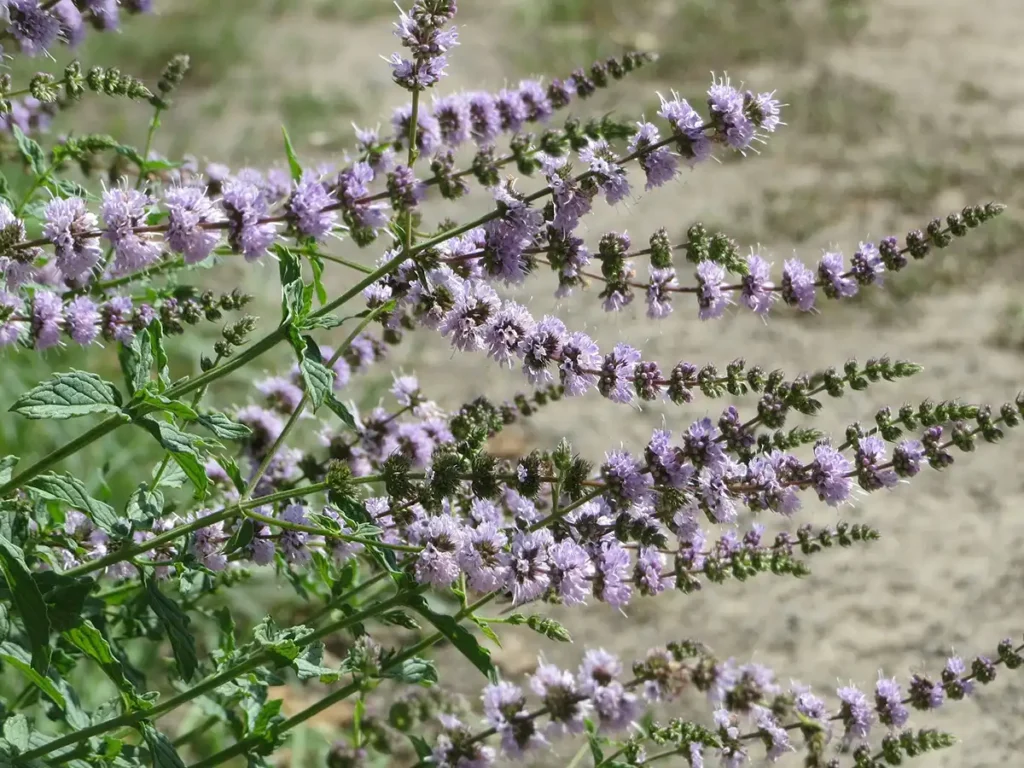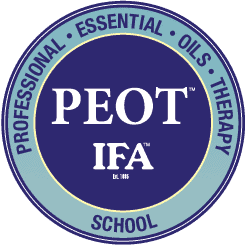Introduction
Essential oils are highly concentrated plant extracts obtained through various methods such as steam distillation, cold pressing, or solvent extraction. They have been used for thousands of years for their therapeutic and medicinal properties. The ancient Egyptians, Greeks, and Romans used them for perfumes, cosmetics, and medicinal purposes.
They gained popularity in the 20th century for aromatherapy, a holistic healing practice that uses them to promote physical and emotional well-being. Today, they are widely used in various industries, such as cosmetics, food and beverage, and pharmaceuticals.
Overview of Spearmint essential Oil - Origin and Extraction Process
Spearmint essential oil is derived from the flowering tops of a perennial plant, which has the INCI name Mentha spicata. This plant is native to Europe and Asia but is now widely cultivated in many parts of the world, including North America, Africa, and Australia.
The extraction process of Spearmint essential oil involves steam distillation of the fresh flowering tops or partially dried leaves of the spearmint plant. The leaves are harvested and then washed to remove dirt or debris. They are then loaded into a distillation chamber where steam is passed through them.
The steam causes the aroma molecules to be released from the leaves, which are carried upwards with the steam. The vapour is then condensed into liquid and collected in a separate container. The water is called a hydrosol or hydrolat and contains many of the plant’s medicinal properties. The extracted essential oils float on the water to be bottled and labelled.
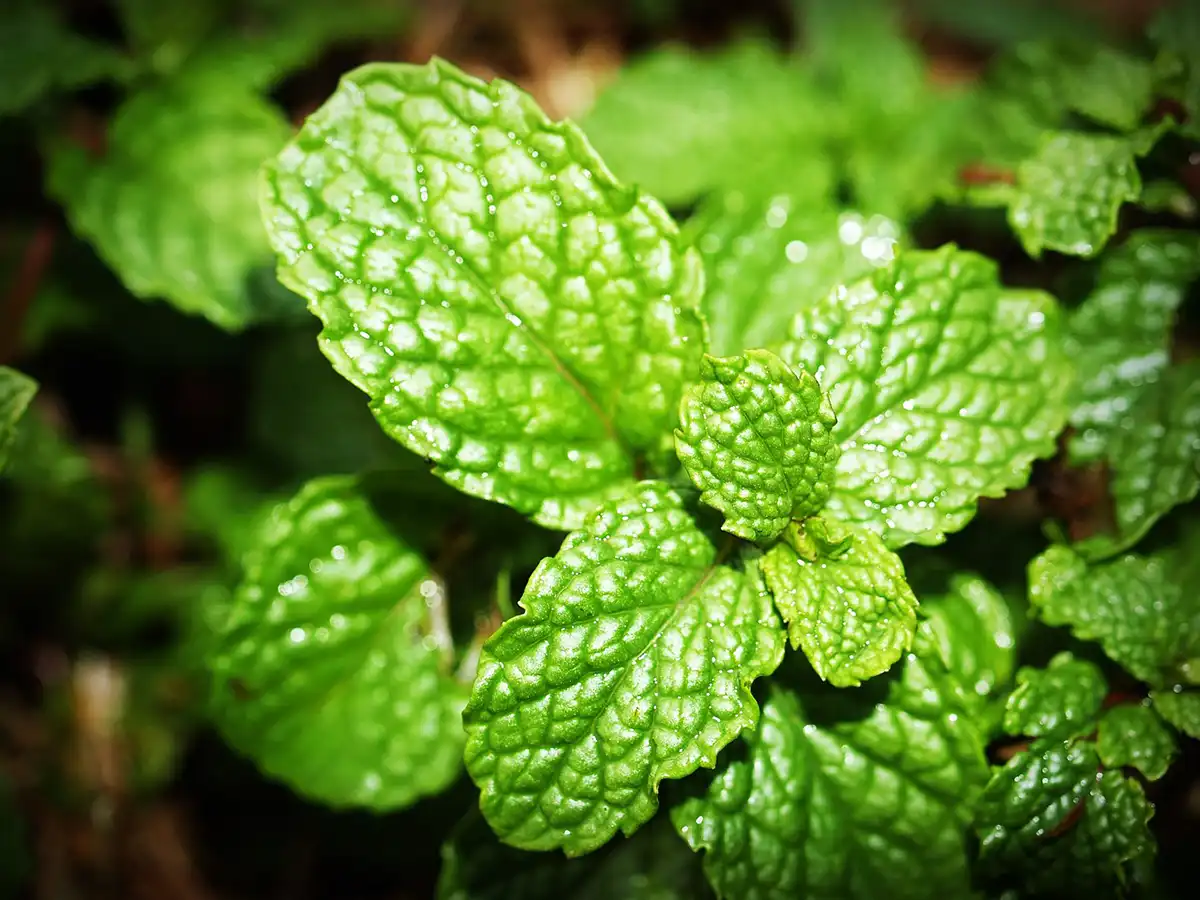
The History and Origin of Spearmint Essential Oil
Tracing the Roots of Spearmint
Mentha spicata is a hardy perennial plant member of the mint family. It is native to Europe and Asia and is commonly known as green mint, lady’s mint, and garden spearmint. The plant’s flowering tops are distilled to make a pale yellow to pale olive-coloured oil with a fresh and sweet minty scent that leaves a tingling sensation in the mouth. It has been cultivated for thousands of years for its medicinal and culinary properties.
The ancient Romans and Greeks used fresh leaves as a digestive aid. The Romans, particularly, would have feasts that lasted for hours with immense volumes of food being eaten. They needed the herb to help stomach problems like muscle contractions in their digestive system and reduce abdominal pain. It was also used to freshen breath and treat headaches.
In medieval Europe, Spearmint oil was used to treat digestive problems and for therapeutic purposes such as respiratory and skin problems.
It was introduced to the US by European settlers in the 17th century. It quickly became popular for its refreshing flavour and fragrance, and it was used in various culinary applications, including teas, candies, and desserts. Spearmint extract is the most commonly used flavour for toothpaste and chewing gum.
Today, Spearmint is grown worldwide, with major producers being the United States, China, and India. It is still used in traditional medicine to relieve nausea and stimulate the taste buds.
Ancient Uses and Folklore related to Spearmint
Spearmint has been used for medicinal and culinary purposes for thousands of years. Ancient Greeks and Romans used it to freshen their breath and treat digestive issues and headaches. In Traditional Chinese Medicine, it is used to treat colds, fevers, and respiratory issues.
It has also been used in folklore and superstitions. In medieval Europe, all plants from the mint family were believed to ward off evil spirits and protect against witchcraft while bringing good luck and prosperity.
In some Native American cultures, Spearmint was used in purification rituals and as a symbol of hospitality. The plant was often burned as incense or added to bathwater to cleanse the body and spirit.
Spearmint is still widely used in cigarettes, food flavourings, teas, chocolates, and chewing gum. It is also popular in oral hygiene products like toothpaste and mouthwash due to its refreshing scent and antibacterial properties.
The Process of Turning Spearmint into Essential Oil
The process involves several steps:
Harvesting: The leaves are harvested at their peak freshness and oil content. This is typically in the early morning when the dew has dried.
Steam distillation: This is the most common extraction method whereby the cut leaves are placed in a still, and high-pressure steam is passed through them. This causes the molecules to rise with the steam into a condenser, which is cooled and collected.
Separation: Once the oil has been collected, it is separated from any water or other impurities that may have been collected during the distillation process.
Testing: The essential oil is then tested for purity and quality to meet industry standards.
Bottling: Finally, the essential oil is bottled and labelled for sale to consumers.
Spearmint can be turned into essential oil in a few hours, depending on the still size and the number of plants processed.
The Chemistry of Spearmint Essential Oil
The main constituents of Spearmint essential oil include:
Carvone: This is the primary constituent, accounting for up to 70% of its composition. It gives the oil its characteristic minty aroma and flavour.
Limonene: This is a terpene that is commonly found in citrus fruits. It has a fresh, citrusy scent and is known for its uplifting and energising properties.
Menthol: This is a terpene that is found in many mint plants, including cannabis. It has a cooling effect on the skin and helps to relieve pain and inflammation.
Cineole: Also known as Eucalyptol, this compound has an energising, camphor-like scent and is commonly found in Eucalyptus oil. It has antiseptic properties and can help to clear the respiratory system.
Linalool: This is a terpene alcohol that is commonly found in many essential oils, including Lavender and Bergamot. It has a floral, woody scent and is known for its calming and relaxing properties.
Beta-Pinene: This terpene is found in many plants, including pine trees and rosemary. It has a fresh, herbal scent and is known for its anti-inflammatory properties.
Rosmarinic Acid: This is a natural antioxidant that is stronger than Vitamin E.
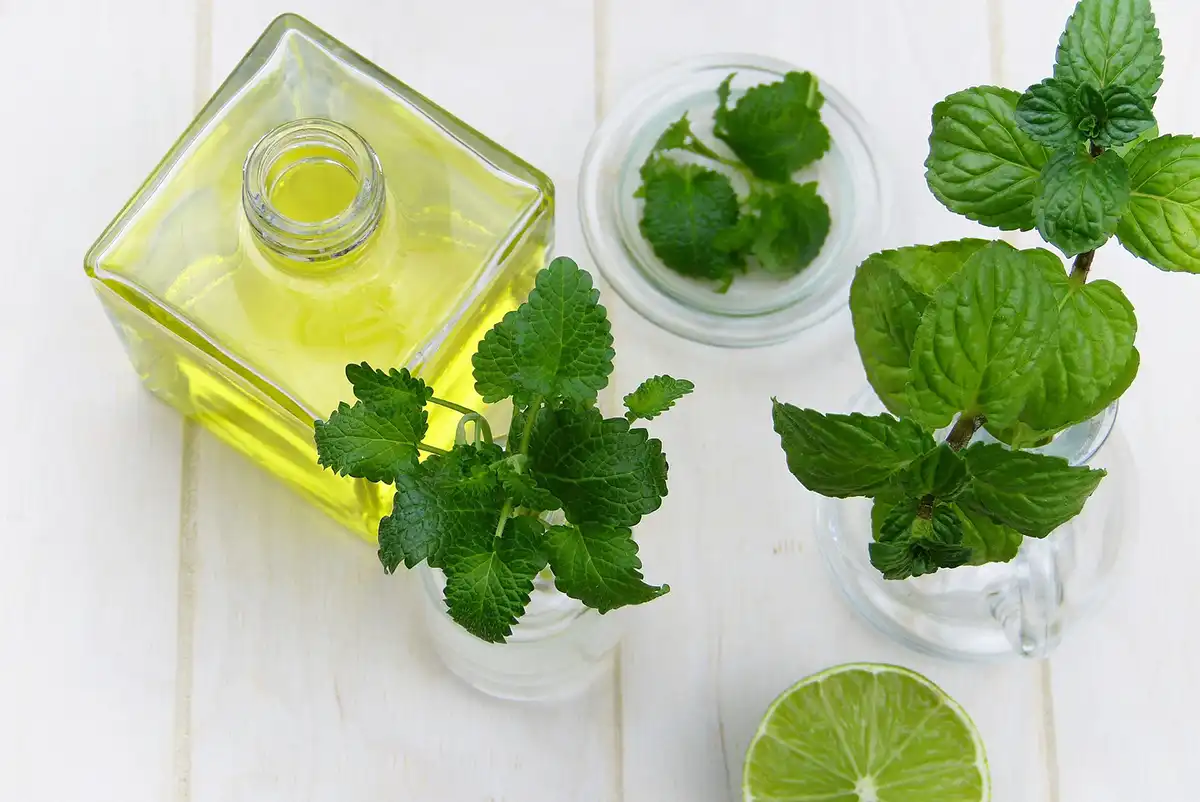
Health and Wellness Benefits of Spearmint Essential Oil
Digestive Health Benefits
Spearmint essential oil has several digestive health benefits, including:
Relieves indigestion: It has antispasmodic properties that help relax the digestive tract muscles, reducing cramps and bloating. It also helps to stimulate the production of digestive enzymes, which aid in the breakdown of food.
Reduces nausea: It has a soothing effect on the stomach and can help to reduce nausea and vomiting. The aroma is particularly effective in reducing morning sickness during pregnancy.
Improves bowel movements: It has mild laxative properties that can help to improve bowel movements and relieve constipation.
Reduces inflammation: Spearmint oil reduces inflammation in the digestive tract, easing symptoms of digestive conditions like IBS and IBD.
Promotes healthy digestion: It helps to promote healthy digestion by improving the absorption of nutrients from food and reducing the risk of digestive disorders.
Respiratory Health Benefits
Spearmint essential oil has several respiratory health benefits, including:
Relieves congestion: It has decongestant properties that help to clear the respiratory tract and relieve congestion. It can be used with conditions like colds, flu, bronchitis, and sinusitis.
Reduces inflammation: It has anti-inflammatory properties that may help to reduce inflammation in the respiratory tract. This can help to alleviate symptoms of asthma and other respiratory issues.
Soothes coughs: It has a soothing effect on the throat and can help to reduce coughing. It can be used by those wishing to ease dry coughs and coughs caused by respiratory infections.
Acts as a natural expectorant: It helps to loosen phlegm and mucus in the respiratory tract, making expelling them from the body easier. This can help to alleviate symptoms of respiratory conditions like bronchitis and pneumonia.
Boosts immunity: It has antimicrobial properties that may help to boost the immune system and protect against respiratory infections. It can also be used to help prevent the spread of airborne pathogens in the home or workplace.
Mental and Emotional Health Benefits
Spearmint essential oil has several mental and emotional health benefits, including:
Reducing stress and anxiety: It has a calming effect on the mind and body, which can help reduce stress and anxiety levels.
Improving mood: The refreshing smell can help uplift your mood and promote a sense of happiness and positivity.
Boosting mental clarity: It helps improve focus, concentration, and cognitive function, making it an excellent choice for studying or working.
Relieving headaches: It has analgesic properties that help to relieve headaches and migraines.
Promoting relaxation: The soothing aroma helps promote relaxation and improve sleep quality when used in small amounts. Try adding a drop or two to the fabric conditioner compartment of your washing machine next time you wash your bedding.
Skin and Hair Care Benefits
Purodem offers cosmetology classes, teaching you how to make lotions and gels for the gym. They can be used before or after the workout. They are also suitable for use in hot weather. The Spearmint oil has a tingling, cooling effect, which is completely refreshing.
-
Amazing foot cream: Spearmint essential oil is antiseptic and antifungal, so it is a good choice to include in foot creams and gels. Spearmint blended with Peppermint is wonderfully cooling for hot, sweaty feet and is a good way to keep Athlete’s Foot under control.
-
Soothes skin irritation: It has anti-inflammatory properties that help soothe skin irritations, dermatitis and reduce redness.
-
Controls acne: It helps to control acne by preventing the growth of bacteria that cause breakouts. It also clears congested skin and blocked pores. The Limonene content promotes cell turnover, which helps to ensure acne scars heal faster.
-
Reduces excess sebum: It helps regulate the production of sebum, which is responsible for oily skin. This can help reduce excess oil and prevent blocked pores. Even better, it has a tightening effect on the skin, which gives a slightly lifted effect.
-
Safe for children: It contains much less menthol than Peppermint essential oil does, so it is safer to use around children. Adding a drop or two to a tissue and placing it under a child’s pillowcase can help to reduce enuresis (bed-wetting). However, always keep essential oils away from children for safety.
-
Promotes hair growth: It stimulates blood circulation in the scalp, promoting hair growth and preventing hair loss.
-
Relieves itchy scalp: The cooling and soothing properties help relieve an itchy scalp caused by dandruff or other conditions. This is perfect to use if you have recently had a weave or hair extensions.
-
Refreshes skin and hair: The invigorating scent helps refresh skin and hair, leaving them feeling clean and revitalised.
-
Natural deodorant: The antimicrobial properties can help eliminate odour-causing bacteria, making it a natural alternative to chemical-laden deodorants.
Antimicrobial Properties
Spearmint essential oil has been found to have antimicrobial properties against a variety of microorganisms, including bacteria, fungi, and viruses. Some studies have shown that it can inhibit the growth of common bacteria such as E. Coli, Staphylococcus Aureus, and Salmonella typhimurium. It has also been found to be effective against fungal infections such as Candida albicans and Aspergillus Niger.
Hormone Imbalances
A women’s study found that Spearmint tea may increase female hormones, but more research is needed to confirm this. It illustrates that there are even more therapeutic uses yet to be discovered.
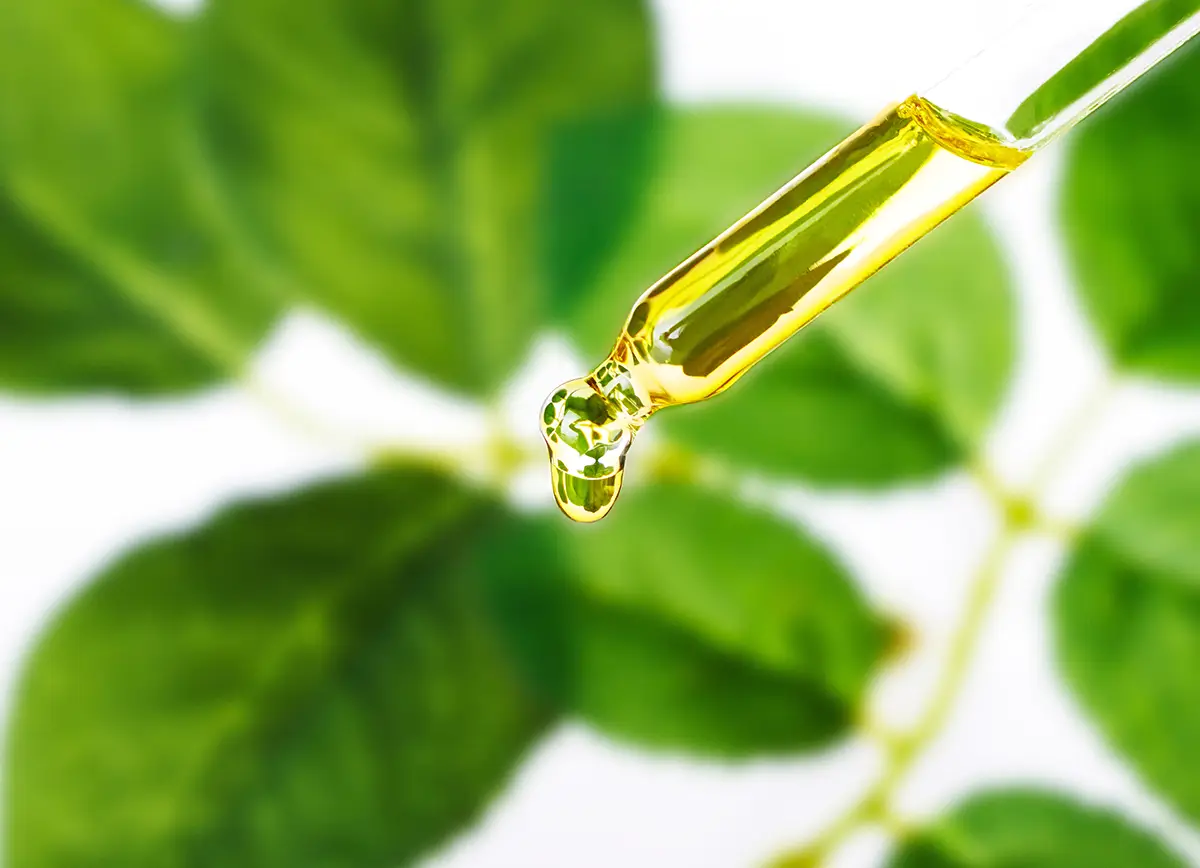
DIY Recipes with Spearmint Essential Oil
There are many ways to use Spearmint as part of a beauty routine, address skin problems and use it around your home. Here are a few ideas to inspire you:
Using Spearmint Oil in Skin and Hair Care Routines
Acne treatment: Spearmint essential oil has antibacterial properties that can help fight acne-causing bacteria. Mix a drop or two with a little Jojoba oil and apply it to your face as a spot treatment. Jojoba helps to unblock congested pores, which can help clear other skin problems like congested skin.
Hair growth: Use Spearmint essential oil to stimulate hair growth by increasing blood circulation to the scalp. Mix a drop with Camellia Seed oil and massage it into your scalp before shampooing.
Deodorant: Melt 1 cup of Coconut oil in a double boiler, then remove from the heat. Add two drops of Spearmint essential oil, then quickly stir in a tablespoon of baking soda. Pour the mixture into a container and let it cool and solidify. Apply with your fingertips for an effective natural deodorant that combats body odour.
Lip balm: To help soothe dry, chapped lips, melt one tablespoon of Beeswax pastilles with two tablespoons of Sweet Almond oil in a double boiler. When melted, pour into a small container and stir in 3 drops of Spearmint essential oil with a cocktail stick.
Inhalation: Add a drop of Spearmint essential oil to a bowl of hot water and inhale the steam. This can help to clear sinuses, relieve headaches, and improve respiratory function. You can then apply a face mask afterwards, as the pores are already open.
How To Use Aromatherapy in the Bathroom
Simple bath soak: Add three drops of Spearmint essential oil to an eggcup full of Grapeseed oil and stir into one tablespoon of Himalayan salt. Add to your bath water for a refreshing and invigorating soak. This can help to soothe sore muscles, improve circulation, and promote relaxation. Remember to wash out the bath afterwards, as it will be slippery.
Muscle soak: Mix 1 cup of Epsom salts with 1/2 cup of baking soda and stir in 10 drops of Spearmint essential oil. Store this in an airtight container until ready to use. When ready, fill your bathtub with warm water and add a 1/2 cup of the mixture. Soak in the tub for at least 20 minutes to allow the Epsom salt to relax your muscles, and the baking soda generally aids in detoxing those tired joints. Rinse off with warm water and pat dry with a towel.
Shower steamers: Stir one cup of baking soda with half a cup of sea or Epsom salt. Add 20 drops of Spearmint oil or blend with other essential oils like Eucalyptus. Press the mixture into a silicon ice cube mould and leave it to dry for 24 hours. Turn them out and keep them in a plastic container. When you have your morning shower, drop a cube onto the floor of your shower cubicle away from the direct stream from the shower head. The steam will release the benefits of Spearmint with a zingy, uplifting effect that helps with easier breathing. Regular use may help with minor respiratory issues, but you should check with your doctor first if you have serious breathing problems.
Incorporating Spearmint Oil in Household Cleaning
-
All-purpose cleaner: Mix 1 cup of water and 1 cup of white vinegar with ten drops of Spearmint essential oil and ten drops of Lemon essential oil in a spray bottle. Use this blend to clean countertops, sinks, and other surfaces.
Shake well to combine and test the cleaner on a small, inconspicuous area before using it on a larger surface. Avoid using it on natural stone surfaces such as marble or granite, as vinegar can etch these materials over time.
Use the cleaner on surfaces such as countertops, sinks, and floors. For tougher stains, let the cleaner sit for a few minutes before wiping clean with a cloth or sponge.
-
Floor cleaner: Add a few drops of Spearmint essential oil with your regular natural floor cleaner to a bucket of warm water and use it to mop your floors. This will leave your floors smelling fresh and clean.
-
Air freshener: You don’t need to buy a diffuser for this recipe. Make a refreshing blend by mixing ten drops of Spearmint oil, five drops of Lavender oil, and five drops of Bergamot oil with 2 oz of distilled water. Put this in a small bottle with a spray top. The oils will not dissolve in the water, so shake it well each time before you spray it around. Avoid spraying directly onto fabrics of polished wood surfaces. Use it to freshen up the air in your home, and keep another bottle by the toilet!
-
Laundry freshener: Add a few drops of Spearmint essential oil to your laundry detergent or fabric softener drawer to give your clothes a fresh scent.
-
Bathroom cleaner: Mix 1 cup of baking soda, 1/4 cup of liquid Castille soap, and 15 drops of Spearmint essential oil in a plastic lunch box. Use this mixture to scrub your bathtub, shower, and toilet. Note: Always test a small area before using any new cleaning product or solution on a larger surface.
-
Diffusion: Diffusing Spearmint oil is wonderful, and many USB rechargeable devices are available that don’t need water and have timers built in. You can set the timers for the length you need, usually between 15 to 30min at chosen intervals throughout the day. Filling your room with the fragrance brings so many benefits.
Spearmint Oil in Massages for Physical Relief
- Massage blend: When used in massages, Spearmint essential oil can help to relieve muscle pain, soreness, and stiffness. It can also help reduce inflammation and swelling in the muscles and joints, making it useful for those coping with arthritis and fibromyalgia. It is important to dilute the essential oil with a carrier oil such as Coconut or Olive. This will help prevent skin irritation and ensure the oil is adequately absorbed into the skin. The massage should be slow and gentle, focusing on any areas of tension or pain.
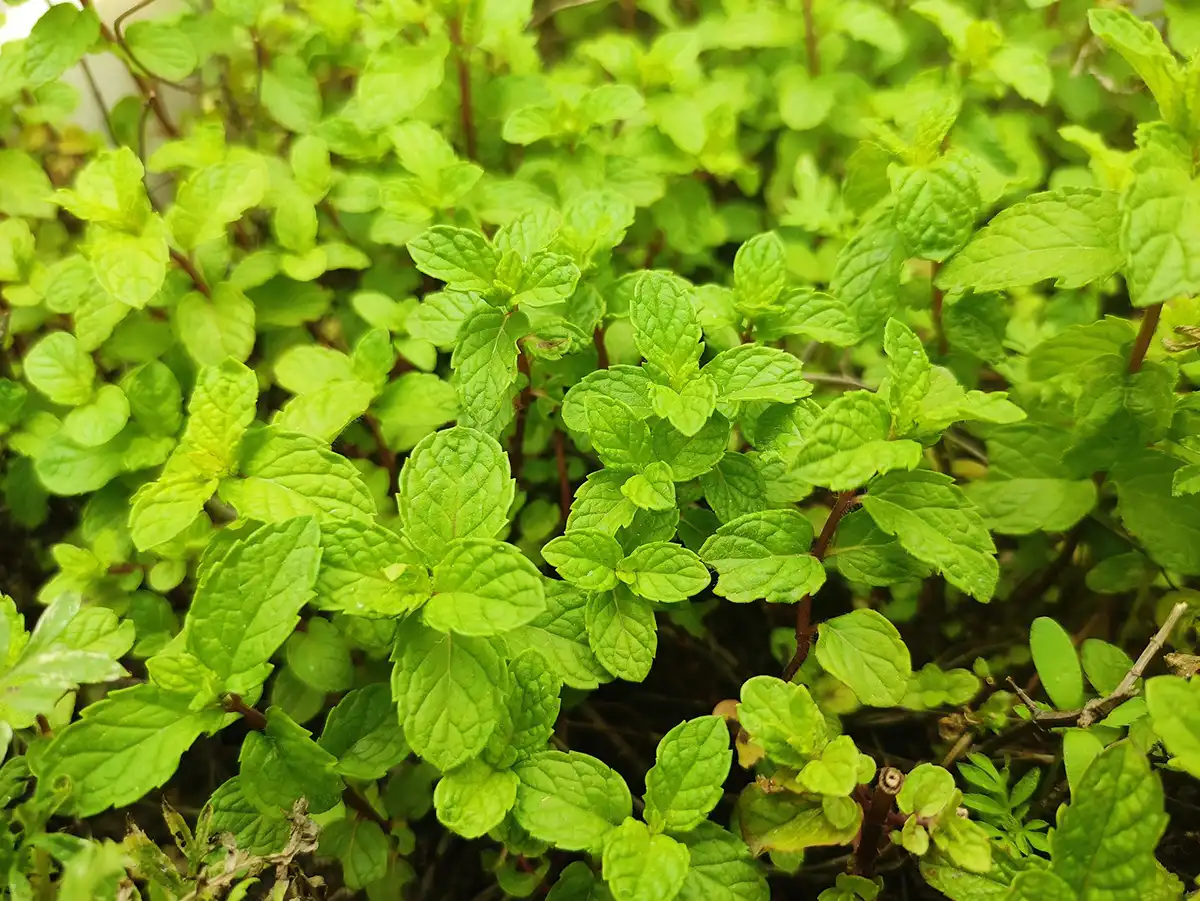
Safety and Precautions When Using Spearmint Essential Oil
General Safety Guidelines for using Essential Oils
Always dilute essential oils before applying to the skin, and do not apply to sensitive areas. Remember that they are highly concentrated and can cause irritation or even burns if applied directly.
Do a patch test before using any new essential oil. Apply a small amount of diluted oil to a small skin area and wait 24 hours for any reaction.
Keep them out of reach of children and pets – some can be toxic if ingested.
Avoid getting them in your eyes, nose, or mouth. If this happens, flush the affected area with water and seek medical attention.
Do not use essential oils on infants or young children without consulting an aromatherapist.
If you are pregnant or have a medical condition, consult an aromatherapist before using essential oil.
Store them in a cool, dark place away from direct sunlight and heat sources.
Please be sure to use caution when diffusing them around pets, as some of them can be harmful to animals.
Always follow the recommended dosage and usage instructions for each essential oil.
If you experience any adverse reactions to essential oil, discontinue use immediately and seek medical attention if necessary.
What are the warnings for Spearmint Essential Oil?
- Skin irritation: There is a slight possibility that it may cause irritation in some individuals with skin sensitivities. Therefore, always use the oil diluted in a carrier oil, and do a patch test first if you know you have sensitive skin.
- Photosensitivity: Even rarer is the potential to increase the skin’s sensitivity to sunlight, which can lead to sunburn or other skin damage.
- Pregnancy and breastfeeding: Pregnant women often have a stronger sense of smell during pregnancy, so start with a small amount to see how it affects you.
- Children: Spearmint EO should not be used on children under six as it may cause respiratory problems.
- Allergic Reactions: Some people may be allergic to spearmint essential oil, which can cause symptoms such as itching, redness, and swelling.
- Before using spearmint essential oil, you must talk to your doctor if you take medications such as blood thinners or diabetes, as they may interact with them.
Is Spearmint Oil safe on the skin?
There are many excellent benefits of Spearmint essential oil, and it is widely recognised as generally safe for use when diluted properly. However, it is important to note that some people may have skin sensitivities or be allergic to Spearmint oil. I recommend doing a patch test before using it; always diluting it with carrier oil before applying it topically. Additionally, pregnant women should consult with their doctor first.
What To Do in case of Adverse Reactions
If you experience adverse reactions, stop using it immediately and seek medical attention if necessary. Some possible adverse reactions may include skin irritation or allergic reactions.
How To Choose High-Quality Spearmint Essential Oil
The Importance of choosing High-Quality Essential Oils
Knowing how to purchase Spearmint essential oil can be confusing to ensure you receive the best quality for a fair price. The quality can vary greatly depending on factors such as the plant source, the extraction method, and the storage conditions. Choosing high-quality essential oils is vital for several reasons:
Safety: Low-quality essential oils may contain impurities or contaminants that can be harmful when inhaled or applied topically.
Effectiveness: High-quality essential oils contain a higher concentration of active compounds, which means they are more effective at delivering their therapeutic benefits.
Aroma: High-quality essential oils have a more vibrant and complex fragrance, enhancing their therapeutic effects and making them more enjoyable to use.
Labelling: To ensure you get the best quality, look for products labelled with the INCI name and a best-before-date. It’s also important to buy from reputable brands that use third-party testing to verify the purity and potency of their products.
Tips for Identifying High-Quality Spearmint Oil
Spearmint essential oil is a very affordable product, but there are some guidelines to be aware of. If the price is very low, it may have been adulterated to keep the cost down. Some MLM companies advertise a lot and charge high fees for their essential oils due to multiple layers of people taking a cut for promoting them. It’s best to avoid such products. The advertising bills alone make up a considerable amount of your price, so we recommend you avoid these companies.
Look for the INCI declaration on the label and choose a supplier with a good reputation for fast turnover. This will help ensure your oil is fresh and not expired. There should also be a best-before date on the label. Have a test sniff if a sample is available.
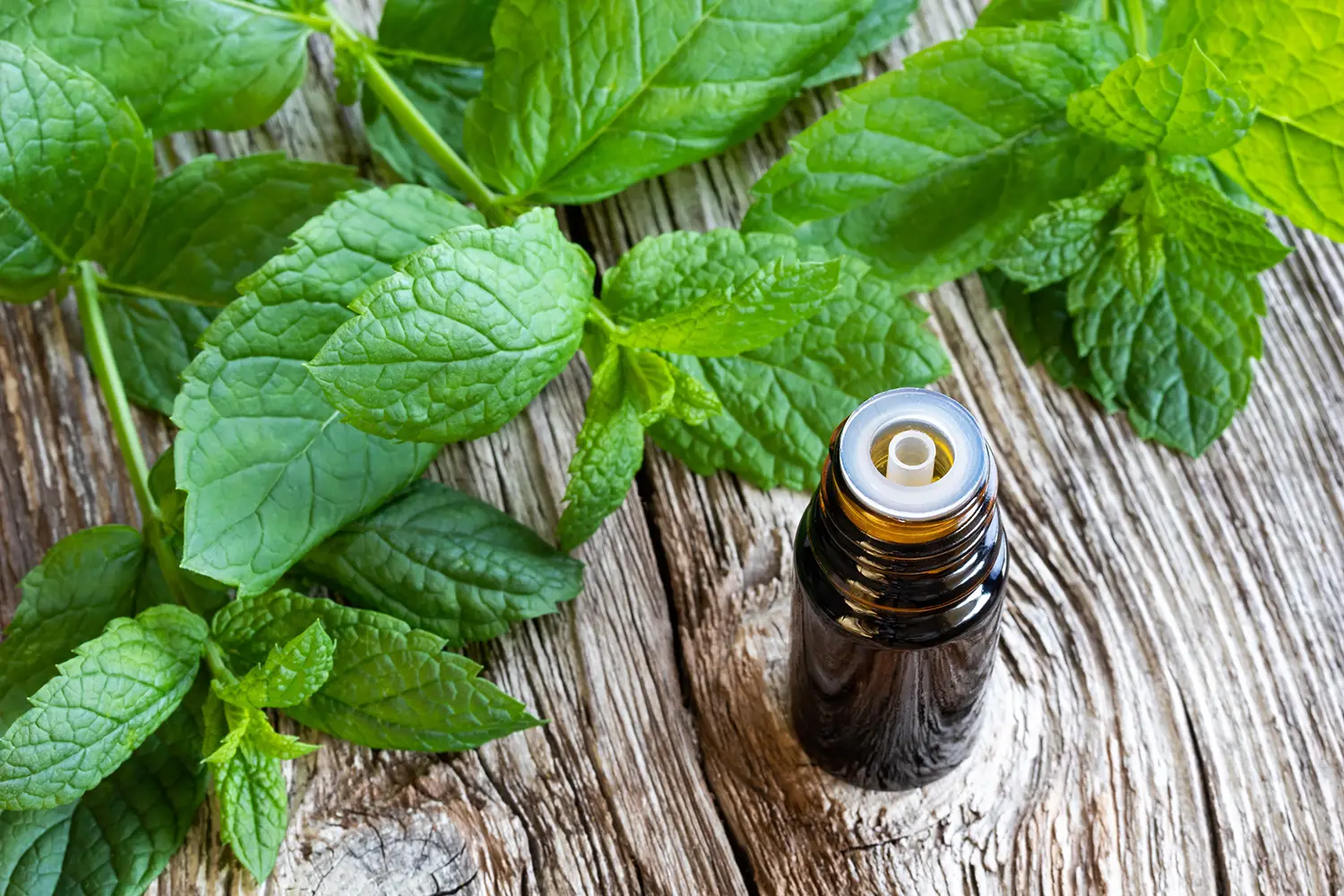
Frequently Asked Questions...
What's the difference between Peppermint Oil and Spearmint Oil?
Peppermint and Spearmint oils are derived from different mint plant species. The main difference between them is their chemical composition and aroma.
Relatively, Peppermint has a higher concentration of menthol than Spearmint oil, which gives it a stronger, more intense cooling sensation. It also has a sharper, more minty aroma with hints of sweetness and spice.
Spearmint oil, on the other hand, has a milder, sweeter aroma with hints of fruitiness. It is often used in culinary applications and oral care products for its refreshing flavour.
Both oils have similar health benefits, including soothing digestive issues, relieving headaches, and reducing stress and anxiety. However, Peppermint oil is generally considered more potent and should be used cautiously in high concentrations.
Is Spearmint essential oil good for sleep?
Yes, Spearmint essential oil can be beneficial for sleep. It has a calming and soothing effect on the mind and body, which can help promote relaxation and improve sleep quality. It also has a refreshing and invigorating fragrance that can help clear the mind and reduce stress and anxiety, making it easier to fall asleep. However, it is important to use Spearmint essential oil safely and in moderation, as excessive use can cause adverse effects.
Read more about The Power of Aromatherapy for Restful Sleep
What can I mix Spearmint oil with?
You can use Spearmint essential oil with vegetable oils such as Coconut oil, Sweet Almond oil, or Olive oil to create a massage oil. This diluted oil can also be mixed with a bubble bath to make an excellent bath soak (be sure to rinse the bathtub afterwards!). You can include it in a wide range of creams, lotions and gels that you will learn how to make for yourself from scratch from our Diploma in Natural Skincare Formulation course.
Is Spearmint oil good for acne?
Yes, it has anti-inflammatory and antimicrobial properties that can help reduce redness and swelling and kill acne-causing bacteria. Spearmint oil also helps regulate sebum production, which can prevent clogged pores and breakouts. This is even better if you combine it with Hazelnut oil, which balances sebum production.
Final Thoughts...
Spearmint essential oil is a versatile and beneficial oil that can be used in various ways. It has a refreshing and uplifting scent that can help to improve mood and reduce stress. It also has many therapeutic properties, including anti-inflammatory, antispasmodic, and analgesic effects, making it popular for massage blends and beauty care.
When using it, you should dilute it properly with vegetable oil and use it in moderation. It should not be ingested or applied directly to the skin without dilution. You can also diffuse it in a room to freshen the air and use it in natural cleaning products or as a natural insect repellent.


